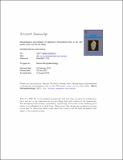Files in this item
Morphological abnormalities of planktonic foraminiferal tests in the SW pacific ocean over the last 550ky
Item metadata
| dc.contributor.author | Mancin, Nicoletta | |
| dc.contributor.author | Darling, Kate | |
| dc.date.accessioned | 2016-09-05T23:32:30Z | |
| dc.date.available | 2016-09-05T23:32:30Z | |
| dc.date.issued | 2015-10-15 | |
| dc.identifier | 215400794 | |
| dc.identifier | 6228ae00-05e0-4f2d-93ec-81b0adce5c79 | |
| dc.identifier | 84941265930 | |
| dc.identifier | 000365064900001 | |
| dc.identifier.citation | Mancin , N & Darling , K 2015 , ' Morphological abnormalities of planktonic foraminiferal tests in the SW pacific ocean over the last 550ky ' , Marine Micropaleontology , vol. 120 , pp. 1-19 . https://doi.org/10.1016/j.marmicro.2015.08.003 | en |
| dc.identifier.issn | 0377-8398 | |
| dc.identifier.other | RIS: urn:32216041D1FE03417F6429B7BCE46750 | |
| dc.identifier.uri | https://hdl.handle.net/10023/9431 | |
| dc.description | This project was funded by “FAR 2012-2014” grants of the University of Pavia (Italy). | en |
| dc.description.abstract | The paper focuses on the occurrence of morphologically abnormal specimens of planktonic foraminifera observed over the last 550ky in IMAGES core MD 97-2114 (East of New Zealand, SW Pacific). Abnormal tests occurred throughout the entire record in all the morphospecies characterising the assemblages but were relatively rare, with percentages not exceeding 1.5% of the total assemblage. No mass abnormality events were found. A range of malformations were observed from slight deformity with smaller or overdeveloped chambers to more severe deformity, with misplaced chambers, distorted spirals or double tests forming twinned individuals. They exhibited several different categories of morphological abnormalities, even within the same sample. Test abnormalities were most abundant in the morphospecies Globorotalia inflata, Globigerina bulloides and Orbulina universa and were characterised by a long-term decreasing trend up core with an alternating % abundance pattern at the glacial to interglacial scale between MIS 14 to MIS 8, recording the highest percentages during the interglacials. Normalised total abundance and abnormal abundance curves co-varied very closely for G. bulloides and O. universa, but for G. inflata two opposing excursions were observed during MIS 13 and 6 which may be linked to water column states. Although abnormal numbers were proportionately low, there appears to be a “natural” background number of malformations in the G. inflata population through time. There was no relationship between volcanic ash production and test abnormalities. | |
| dc.format.extent | 3331323 | |
| dc.language.iso | eng | |
| dc.relation.ispartof | Marine Micropaleontology | en |
| dc.subject | Planktonic foraminifera | en |
| dc.subject | Abnormal test | en |
| dc.subject | Environmental stressors | en |
| dc.subject | Pleistocene, SW pacific | en |
| dc.subject | GE Environmental Sciences | en |
| dc.subject | DAS | en |
| dc.subject.lcc | GE | en |
| dc.title | Morphological abnormalities of planktonic foraminiferal tests in the SW pacific ocean over the last 550ky | en |
| dc.type | Journal article | en |
| dc.contributor.institution | University of St Andrews. School of Geography and Geosciences | en |
| dc.identifier.doi | 10.1016/j.marmicro.2015.08.003 | |
| dc.description.status | Peer reviewed | en |
| dc.date.embargoedUntil | 2016-09-05 |
This item appears in the following Collection(s)
Items in the St Andrews Research Repository are protected by copyright, with all rights reserved, unless otherwise indicated.

